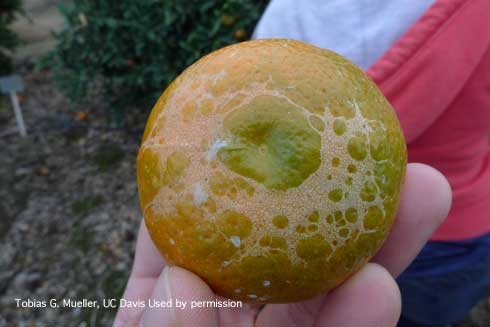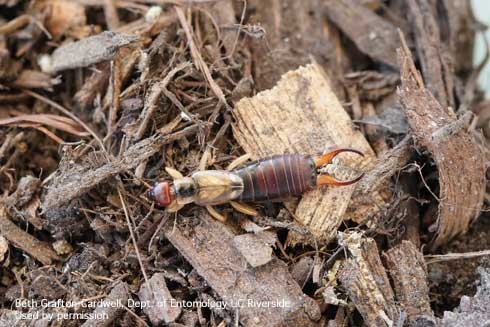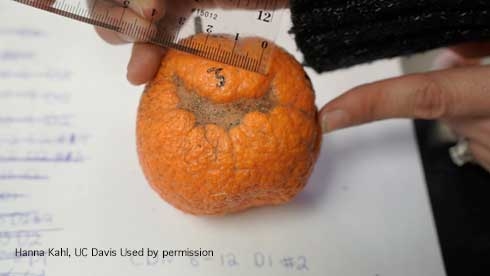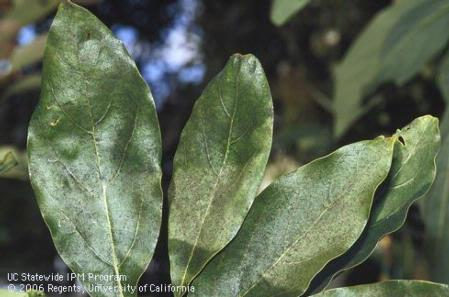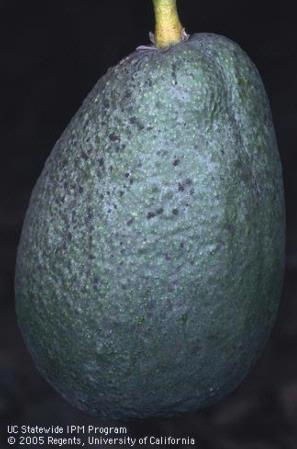- Author: Ben Faber
The UC IPM Citrus Pest Management Guidelines has been updated to include new research out of the Rosenheim lab at UC Davis. Early-season pests like citrus thrips, earwigs, and katydids damage some types of mandarins differently. Learn how to adjust your management program accordingly. Many new photos have been added to these sections to improve pest identification and show more damage symptoms.
Scarring on the stylar end of citrus fruit caused by citrus thrips, Scirtothrips citri, feeding. Photo credit: Tobias G. Mueller
Adult male European earwig, Forficula auricularia. Photo credit: Beth Grafton-Cardwell.
Scar on citrus fruit caused by European earwig, Forficula auricularia, feeding. Photo credit:Hanna Kahl.
- Author: Ben Faber
Newly Improved Thrips Key
The online Lucid Key, Thrips of California (https://keys.lucidcentral.org/keys/v3/thrips_of_california/Thrips_of_California.html), that identifies native and pest thrips resident in California, along with potentially invasive species not yet present in California, has been updated.
The revised version, Thysanoptera Californica (https://keys.lucidcentral.org/keys/v3/thrips_of_california_2019/), has been produced to overcome technical problems arising from Java software and to incorporate new information and images, together with some additional potentially invasive thrips species. Information pages are provided to 300 thrips species in 108 genera, with the identification system discriminating 249 species. Of these species, 40 are as yet unrecorded in California but are potential invaders, whether interstate or from overseas.
Remember, if you have one or many of these insects, there is always an "s" at the end of their name. One thrips is a thrips, three thrips are thrips.

- Author: Ben Faber
Anthracnose, Sunblotch, and Armillaria Root Rot
Avocado Trunk Canker and Collar Rot
Avocado Branch Canker (Botryosphaeria)
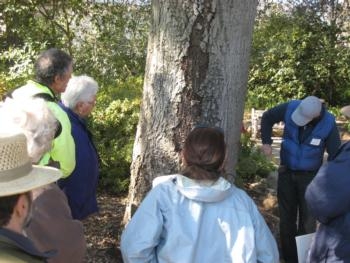
- Author: Ben Faber
We live in unusual times and every year is different, so we are bound to see things that are different, or see things differently. Recently a pest control advisor brought in a sample of what looked like black scale (Saissetia oleae) on the stems of avocado fruit. Along with the scale came a mess of Argentine ant and sooty mold. The PCA had not seen this scale on avocado before. It is common on citrus and, from the name, it is also found on olives and over 100 other host-plants. I hadn't seen it on avocado before, and became somewhat alarmed and sent samples off to UC Riverside for identification. I thought maybe there might have been an introduction of a new scale, riding on imported fruit. Joe Morse and crew from UCR had done a study monitoring fruit coming across the border and found several scales on fruit that were not currently in California:
http://entnemdept.ufl.edu/Hodges/als4161/Secure/PDF%20Files/Articles/AvocadoPhytosanitaryRisks.pdf
Back with the first infestations of Avocado thrips in 1996, PCA Charlie Gribble kept saying that he was finding citrus thrips in avocado. The avocado orchards where he found the thrips were next to a lemon orchard and we kept saying that the insect was probably just getting lost between the two orchards. Well it turned out, it wasn't citrus thrips, but an all new thrips previously undescribed that has gone on to cause a lot of disruption to the California avocado industry. And from here, avocado thrips has gone on to Israel and Spain to cause similar problems. It was better to find out sooner than later it this scale was something new.
I also put the word out to local PCAs and growers asking if they had seen “black scale” this year. The responses were interesting. One grower said that he had seen it occasionally on avocado trees for the last 30 years. They were on older trees and wood. They would be in small numbers in orchards some years and not others. Two PCAs said that they saw it occasionally on young trees, but they were usually parasitized, with wasp exit holes. One PCA said that the scale was only there when there were lots of ants present to fend off parasitic wasps.
Photos: parasitic wasp laying eggs and exit hole of young wasp from adult scale
And bingo, that was the case in this organic orchard with smaller trees. The Argentine ants were protecting the scale and the scale was thriving as evidenced by the sooty mold.
The black scale samples sent into Paul Rugman-Jones at UCR Entomology were identified as the scale Saissetia olea and that virtually all of them were parasitized by the Coccophagus rusti wasp. So it's not a new scale and it's under biological control.
Photos: Sooty mold on avocado leaves and fruit
Nice coverage of scales:
https://www.dialenvironmental.com/images/scales.pdf
http://ipm.ucanr.edu/PMG/r107301411.html
For a guide to the scales of California, big files and illustrations:
https://www.cdfa.ca.gov/plant/PPD/publications/tech_series.html

- Author: Ben Faber
|
RECOGNIZING NATURAL ENEMIES Proper identification of pests, and distinguishing pests from natural enemies, is essential for effective biological control. Carefully observe the mites and insects on your plants to help discern their activity. For example, some people may mistake syrphid fly larvae for caterpillars. However, syrphid fly larvae are found feeding on aphids and not chewing on the plant itself. If you find mites on your plants, observe them with a good hand lens. Predaceous mites appear more active than plant-feeding species. In comparison with pest mites, predaceous mites are often larger and do not occur in large groups. Consult publications listed in the References to learn more about the specific pests and their natural enemies in your gardens and landscapes. Take unfamiliar organisms you find to your local University of California (UC) Cooperative Extension office, UC Master Gardener Program, or agricultural commissioner office in your county for aid in identification. CONSERVATION: PROTECT NATURAL ENEMIES Preserve existing natural enemies by choosing cultural, mechanical, or selective chemical controls that do not harm beneficial species. Remember, only about 1% of all insects and mites are harmful. Most pests are attacked by multiple species of natural enemies (Table 1), and their conservation is the primary way to successfully use biological control. Judicious (e.g., selective, timing) pesticide use, ant control, and habitat manipulation are key conservation strategies. Ant Control and Honeydew Producers The Argentine ant and certain other ant species are considered pests primarily because they feed on honeydew produced by insects that suck phloem sap, such as aphids, mealybugs, soft scales, psyllids, and whiteflies. Ants protect honeydew producers from predators and parasites that might otherwise control them. Ants sometimes move these honeydew-producing insects from plant to plant (called “farming”). Where natural enemies are present, if ants are controlled, populations of many pests will gradually (over several generations of pests) be reduced as natural enemies become more abundant. Control methods include cultivating soil around ant nests, encircling trunks with ant barriers of sticky material, and applying insecticide baits near plants. See Pest Notes: Ants for more information. Mark Hoddle at UC Riverside is working on a gel formulation to attract ants selectively for their control: http://biocontrol.ucr.edu/hoddle/. Habitat Manipulation Plant a variety of species that flower at different times to provide natural enemies with nectar, pollen, and shelter throughout the growing season. The adult stage of many insects with predaceous larvae (such as green lacewings and syrphid flies) and many adult parasites feed only on pollen and nectar. Even if pests are abundant for the predaceous and parasitic stages, many beneficials will do poorly unless flowering and nectar-producing plants are available to supplement their diet. To retain predators and parasites, grow diverse plant species well adapted to the local conditions and that tolerate low populations of plant-feeding insects and mites so that some food is always available. Other cultural controls that can help natural enemies include reducing dust and properly fertilizing and irrigating. Dust can interfere with natural enemies and may cause outbreaks of pests such as spider mites. Reduce dust by planting ground covers and windbreaks and hosing off small plants that become excessively covered with dust. Avoid excess fertilization and irrigation, which can cause phloem-feeding pests, such as aphids, to reproduce more rapidly than natural enemies can provide control. REFERENCES Dreistadt, S.H., M.L. Flint, and J.K. Clark. 2004. Pests of Landscape Trees and Shrubs: An Integrated Pest Management Guide. 2nd ed. Oakland: Univ. Calif. Agric. Nat. Res. Publ. 3359. Flint, M.L. and S.H. Dreistadt. 1998. Natural Enemies Handbook: The Illustrated Guide to Biological Pest Control. Oakland: Univ. Calif. Div. Agric. Nat. Res. Publ. 3386. Rust, M.K. and D.-H. Choe. 2012. Pest Notes: Ants. Oakland: Univ. Calif. Agric. Nat. Res. Publ. 7411.
|
||||||
|
: |
NATURAL ENEMIES |
|||||
|
PESTS |
Lacewings |
Lady beetles |
Parasitic flies |
Parasitic wasps |
Predatory mites |
Other Groups and Examples |
|
aphids |
X |
X |
|
X |
|
entomopathogenic fungi, soldier beetles, syrphid fly larvae |
|
carpenterworm, clearwing moth larvae |
|
|
|
X |
|
entomopathogenic nematodes |
|
caterpillars (e.g., California oakworm) |
X |
|
X |
X |
|
Bacillus thuringiensis, birds, entomopathogenic fungi and viruses, predaceous bugs and wasps,Trichogramma spp. (egg parasitic wasps), spiders |
|
cottony cushion scale |
|
X |
X |
|
|
Cryptochaetum iceryae (parasitic fly), vedalia beetle |
|
elm leaf beetle |
|
|
X |
X |
|
Erynniopsis antennata (parasitic fly),Oomyzus (=Tetrastichus) spp. (parasitic wasps) |
|
eucalyptus longhorned borers |
|
|
|
X |
|
Avetianella longoi (egg parasitic wasp) |
|
eucalyptus redgum lerp psyllid |
|
|
|
X |
|
Psyllaephagus bliteus (parasitic wasp) |
|
giant whitefly |
X |
X |
|
X |
|
Encarsia hispida, Encarsia noyesi, Entedononecremnus krauteri, andIdioporus affinis (parasitic wasp), syrphid fly larvae |
|
glassy-winged sharpshooter |
X |
|
|
X |
|
assassin bugs, Gonatocerus spp. (egg parasitic wasps), spiders |
|
lace bugs |
X |
X |
|
X |
|
assassin bugs and pirate bugs, spiders |
|
mealybugs |
X |
X |
|
X |
|
mealybug destroyer lady beetle |
|
mosquitoes |
|
|
|
|
|
Bacillus thuringiensis spp. israelensis, mosquito-eating fish |
|
psyllids |
X |
X |
|
X |
|
pirate bugs |
|
scales |
X |
X |
|
X |
X |
Aphytis, Coccophagus, Encarsia, andMetaphycus spp. parasitic wasps |
|
slugs, snails |
|
|
X |
|
|
Rumina decollata (predatory snail), predaceous ground beetles, birds, snakes, toads, and other vertebrates |
|
spider mites |
X |
X |
|
|
X |
bigeyed bugs and minute pirate bugs,Feltiella spp. (predatory cecidomyiid fly larvae), sixspotted thrips, Stethorus picipes (spider mite destroyer lady beetle), predatory mites |
|
thrips |
X |
|
|
X |
X |
minute pirate bugs, predatory thrips |
|
weevils, root or soil-dwelling |
|
|
|
X |
|
Steinernema carpocapsae andHeterorhabditis bacteriophora(entomopathogenic nematodes) |
|
whiteflies |
X |
X |
|
X |
|
bigeyed bugs and minute pirate bugs,Cales, Encarsia, and Eretmocerus spp. parasitic wasps, spiders |
Predatory mite going after citrus red mite



